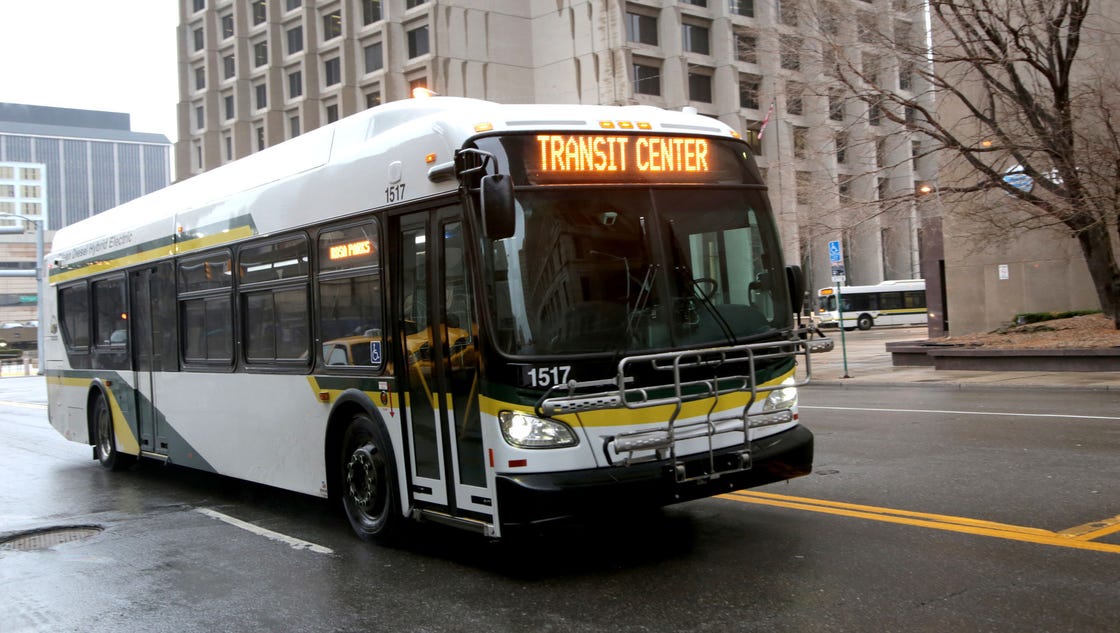Well, the final - long-delayed - public meeting series has wrapped up for the feasability assessment of the North-South Rail project. That's the commuter service proposed eleven years ago to serve between Howell and Ann Arbor, affectionately known as Wally.
Playing "by the rules", Wally gets a grade of C from the project team.
Only a C?
As Bob Moore (Quandell Consulting's engineer on the project) explained it, the likelihood of getting Federal funds to continue the project depend, at this stage, on a preliminary analysis of its cost-effectiveness. This is currently calculated by a Federal Transit Administration (FTA) prescribed formula of the cost of each individual trip, given the ridership forecast generated by an FTA approved forecasting model called STOPS.
Nobody know exactly how STOPS works, except that it takes data on commuter flows, job locations, and demographics; and comes out with an estimate that allows FTA to compare projections across the country on the same, even footing. So even though we don't know how it works or (necessarily) trust it, we know it's the only model that could - just possibly - get more federal funding for Wally. (The current study was funded by about $800K in federal, and much less in state/local money.)
Several service configurations were analyzed, and two emerged as worth bringing forward:
Option 1: Full Service. Between downtown Howell and downtown Ann Arbor, 30 miles. Four trains to Ann Arbor in the morning, four to Howell in the evening. Daily one-way riders' trips, according to STOPS: 1,840 initially, growing to 2,346 by 2040. Capital to put it into service, a generously estimated $122.3M, with $13.2M to operate it. What would a trip cost the rider? For a single one-way ticket between Ann Arbor and Howell, the team thought $6 looked about right, taking into account what other commuter services around the country are charging. The trip would take 51 minutes, which is longer than by car, except during rush hours - which are the only times the trains would run under this option). During rush hour, it takes longer by car, but you can never tell how much longer, because the frequent incidents and weather events make the commute very unpredictable. Cost to operate: $4.55 per trip, achieving FTA rating Medium Low (C- in school-jargon).
Option 5b: Shuttle with two trains. Between Whitmore Lake and downtown Ann Arbor, 11 miles. Four trains to Ann Arbor and two returning to Whitmore Lake in the morning; four to Whitmore Lake in the evening and two returning to Ann Arbor. Capital $65.2M; operating expense $7.0M per year. Daily trips according to STOPS: 1,670 initialy, and 2,420 by 2040. Time: 21 minutes, fare $2. Cost to operate: $2.68 per trip, earning FTA rating Medium (call it a C).
I'd like to go into a lot more detail on what each option involves - particularly where all the money is going and what might be done to reduce the cost. I'll do that soon, time permitting.
By the Rules - Which Rules?
Since this study started in 2014, the terms of the contract required an exposition of rules under the Obama administration. Those are the rules nominally in effect now, but the Trump administration and allies in Congress propose serious changes to the rules.
First, they want the rules for project-funding to be simpler and require less environmental study.
Second, they want to eliminate most funding to public transportation that benefits communities without making a profit. In effect, it will become easier to apply for non-existent funding.
As a result, the new federal rules - when they are enacted - will have a weighty, but unknown impact on Wally and all other attempts to expand public transportation.
New Reality
On the other hand, the current administration would like to involve more private entities, encouraging them to invest money in "infrastructure". Unfortunately, their campaign rhetoric didn't specify exactly what kind of infrastructure they want this to include. In effect, this will leave the decision to "the market" - which will invest in projects with the highest direct monetary return.
So communities like Livingston and Washtenaw that want to improve themselves through public transportation will have to look elsewhere for others to pay for their infrastructure.
Certainly, the name of the game for quite a while has been to find someone else to pay for our benefits. We wrestled with this in February at WATS, after learning that Michigan's Department of Transportation doesn't have money for community-led projects, like a safety island for pedestrians to cross Washtenaw Avenue just east of U.S. 23. But we're not willing to set a precendent to pay for our own pedestrian safety on a state-owned highway. That's understandable, but the need to pay for our own community amenities will only increase over the coming years. However, that's a topic for another blog.
Wally's Next Baby-Steps
Most of us who want to get aboard Wally are very frustrated. This "baby" is taking SO long to learn to walk!
Some have said it's being analyzed to death, but it might be more accurate to say it's being neglected to death. The first analysis was done in 2008; this next step, more detailed and involving more federal safety requirements (particularly positive train control) was supposed to take 18 months, but took closer to 36. Why? I've never been able to learn why. "Names are not being revealed in order to protect the guilty," as they say.
Up to now, AATA and AAATA have acted as custodian of the "baby", but really only as foster-parents. The Authority doesn't have experience running trains, and doesn't run anything - even buses - in Livinston County. In order to move forward, some loose form of coalition, possibly under Michigan's "Act 7" according to the study, will need to band together to find money for the next phase of the project.
Fortunately, there is a dynamic group in Livingston County calling themselves the "Livingston Transportation Coalition" moving forward "with vigor" to get a county-wide Livingston Transportation Authority started.
There is no Wally support group active in Washtenaw County that I know of. The original Wally Coalition, which I believe started around 2005, is sadly dispersed. Prominent members included Dick Carlisle, a Principal of the Carlisle-Wortman Associates planning firm; Tony Vander Worp, Washtenaw County Planning Director (in the days when there was one); and W.O.P. John, artist and entrepreneur, who developed the lovable smiling Wally locomotive logo.

The Wally Coalition has been succeeded by the Friends of Wally. They have a respectable mailing list and friends list, and a small but active core chaired by Mike Lamb of Howell, drawing almost all its active members from Livingston County. (Full disclosure: I am the "token" Washtenaw County member on the Friends' Board.) They have been very helpful in keeping Wally in the public and official eyes of Livingston: updating a Facebook page, setting up booths at fairs, organizing people to speak up at city- and county-council meetings, and working as part of the Livingston Transportation Coalition.
In both counties, anti-tax agitators will predictably be a challenge to getting the project going. My belief, though, is that even people who are reasonably well-disposed to public transportation will need more to vote for than either of the rail commuter services being proposed.
So, What Else?
Here's the problem. Wally would be a great help to some of the people living near the proposed stations at Whitmore Lake, and if/when the full service option gets going, those up the line in Hamburg, western Brighton, and Howell. But as I see it, neither of the proposals as offered in the study deliver enough value for enough voters to come anywhere near passing, no matter how the voting districts are drawn. There are several limitations to the proposals that lead me to that conclusion.
First, the areas served. If all the service runs in to Ann Arbor on weekday mornings and back in the evenings, practically nobody living in Ann Arbor would have any use for it. In Washtenaw County, only residents of Northfield Township (Whitmore Lake) would benefit directly. Certainly Ann Arbor would benefit by not having as many cars pouring in, clogging the streets and demanding parking, but residents of the City see the residents further north as being "to blame" for the problem. "Let them move to the city!" is the refrain I hear quite often, and though I don't believe Ann Arborites would like it if that happened (be careful what you wish for!) it's simply unreasonable in American society to expect suburban and exurban people to move to cities in large numbers.
Second, the times service is offered are not enough. Rush-hour in and rush-hour out is when train service is of greatest value to the largest number, true. But the lack of provision for shift workers (hospital, IT, and other large employment groups) and irregular travelers (university students and faculty, hospital visitors, outpatients, and tourists seeking to avoid downtown Ann Arbor parking hassles) seriously reduces the number of people who could use it. The answer is to provide regular bus service for those who work odd and irregular hours, when traffic on parallel U.S.23 makes it possible to meet schedules reliably.
Third, the lack of connections. Neither Whitmore Lake nor Livingston County have anything like a bus service to get poeple to the stations. Regions where commuter trains operate with full loads have a combination of park-and-ride lots and buses that get people to the stations. Buses make it reasonable for a family to have only one car (or *gasp* none at all, if they live close enough to stores, etc.).
If supplementary and connecting bus service is offered as part of a "package" along with Wally, it stands a much better chance of being accepted by voters. Sure, it would cost more! But it would deliver meaningful benefits to many more people - maybe even enough to pass a millage.
How this "package" is put together is the next step we need to be working on.
























